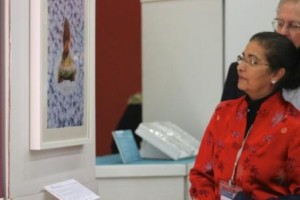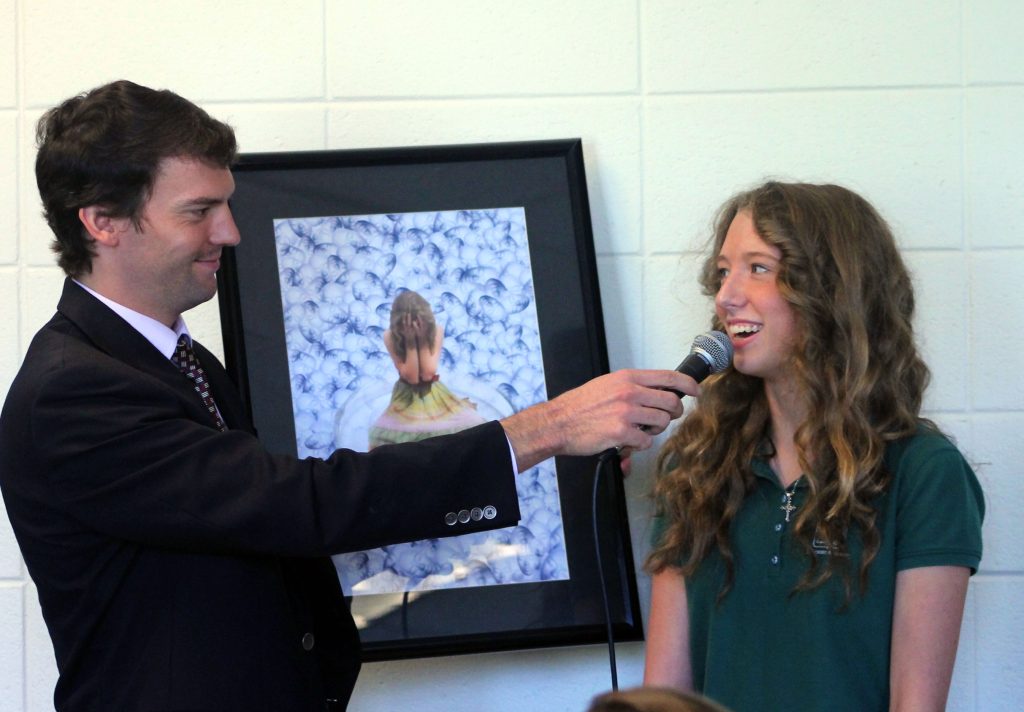The Anáhuac University in Mexico City displayed the winning pieces of the 2011 and 2013 Bioethics Art Competition in its school of architecture during the Fourth International Bioethics, Multiculturalism and Religion Conference in Mexico City. The following is a personal reflection shared at the exhibit’s opening ceremony from art gallery owner Yvonne Denbina, one of the competition’s founders. Her account expresses how the works have stimulated minds and touched hearts around the world. Her experience also suggests that future competitions will continue foster the art of convergence and cooperation in global ethics through the universal language of art. A catalogue of the winning pieces can be found online for 2011 competition here and for the 2013 competition here.
I am an humble artist, not a bioethicist nor a philosopher. But I have listened with interest to those present in the conference this week as they have discussed many ideas, elaborated with many words. In September of 2010, Father Joseph Tham and Alberto Garcia visited my art gallery in Old Town Spring, Texas and shared with me their mission to explore ways to connect art and Bioethics. I shared with them my experiences with the art competitions that I had organized in my gallery to benefit breast cancer research. Marie Valdez, a friend and an art professor, was also in the gallery that day and the four of us began exchanging possibilities, discussing ideas. A week later, a group of friends gathered at my house to hear Father Tham and Dr. Garcia’s remarks about the UNESCO Chair and soon we had a competition underway.
From thoughts, come words, then action. I stand before you today with a whole array of thoughts, which begat words in the form of artist statements and then actions in the images you see in this exhibition. In the course of four years, as the art has been exhibited in Rome, New York, Houston, Hong Kong, Spring and The Woodlands, TX, I have spoken with many people as they view the images. I would like to share some of those conversations with you.
In the first image, “Sisters”, we have a black and white photograph of two young women, one black, the other white, with similar hairstyles and beautiful complexions. They are facing each other, touching at the forehead, with a long strand of natural pearls connecting them around the neck. A woman in the gallery asked me, “Do you really believe that? That they are Sisters?” I wasn’t sure if she was asking me whether their familial relationship was possible, or if they could be as sisters in a social relationship. I responded, “look at their beautiful complexions, their similarities….” She was quick to respond, “No, I don’t believe that can be, or should be.”
I drew her attention to another image of two nearly identical human hearts, with dissection around the same vessels, “Hearts.” “Look at this picture,” I said. “Can you tell me if this heart belongs to a black person or a white person? A Buddhist? A Norwegian? A Communist? We all have hearts and skin and we are all human. Aren’t we brothers and sisters because we are all human?”
In another example, “Olga” we have a photograph taken of a 92-year-old woman living with her daughter and family. She suffers from dementia and is bedridden. A frequent response to this image is that of individuals recoiling and expressing their inability to look at the photograph. I ask why this is so painful for them. They respond that it reminds them of a family member who was in a nursing home or hospital. I am able to relay the artist’s information that in this situation, Olga is at home in familiar surroundings cared for by those who know her and love her. Dying is a part of life, just like birth. If, as in Olga’s case, we are fortunate to see a long life, and we are given the time to experience a dying process, we must remember to celebrate the life spanning birth and death. Each day of life is a gift, whether it is difficult or exhilarating. We must all go through death, not as a process to fear, but a transition that concludes the opportunities we choose on Earth. It is natural and it may or may not have complications, but it is not a process to recoil from.
The opportunity for dialogue occurs when we offer the stimulus for provocative interaction. The winning images in the competition are selected by international judges in the arts and sciences. These images selected represent the artists speaking through their images and words. I, the artist, share my heart with you the viewer and you, the viewer, share with those you know what your impressions and responses may be. We begin a ripple of love. And that is how we affect the world: with ripples of love, with conversations about what we have in common, how we are united in finding comfort and how we long to live in love and peace.


